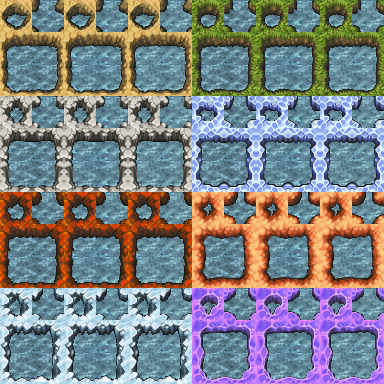

These are tiles which the player will jump over. The existing terrain tags are as follows: Terrain tags allow certain tiles to have special properties, such as being tiles on which wild Pokémon encounters can occur, or tiles that the player can slide around on. Terrain Tag - A number that gives the tile other properties as defined in the scripts.it indicates that the tile is part of a counter or desk). Counter Flag - Whether the player can "reach over" the tile to interact with an event on the other side (i.e.Bush flag - Whether the bottom part of an event on that tile should be transparent, making it look like it is standing in tall grass, shallow water, etc.The player will pass behind any tile that has a non-zero priority. A higher number means it is closer to the foreground. Priority - How close to the foreground the tile is displayed.Passage (4 dir) - The sides which the player/NPC can pass through.Passage - Whether the player or an NPC can walk over them or not (without any special effects applying).The properties of tiles in a tileset are: Here you can edit the contents and properties of tilesets. In RPG Maker XP, click the Database icon in the toolbar, or go to Tools>Database, or press F9. Each autotile is a separate picture file in the folder "Graphics/Autotiles". These are added onto the top of the tileset as the top row of tiles. RPG Maker XP allows you to include up to 7 autotiles in each tileset. RPG Maker XP can handle up to 999 different tilesets, which should be more than sufficient for even the largest of games.Įditing a tileset is as simple as editing a picture.

Tilesets are kept in the folder "Graphics/Tilesets". A tileset is exactly 8 tiles wide, and any number of tiles high (there is a limit of about 5000, but this is usually way more than enough). A tileset is a tall, thin picture made up of squares, or tiles. Tilesets are used to create maps in RPG Maker XP.


 0 kommentar(er)
0 kommentar(er)
